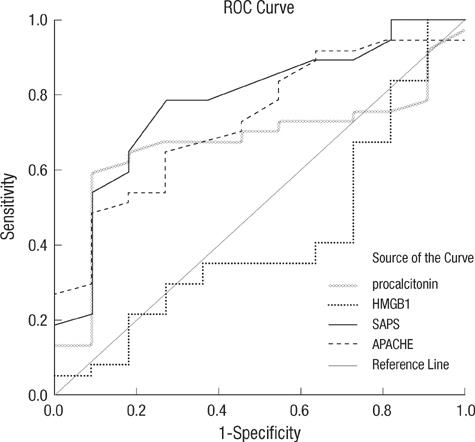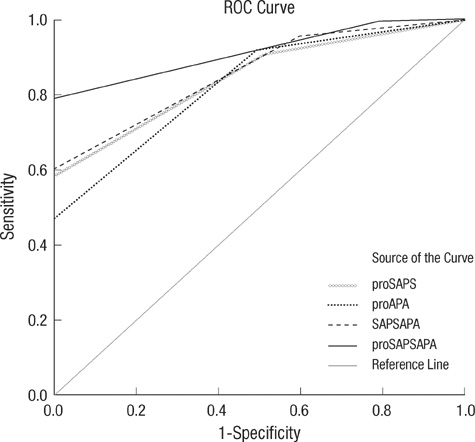J Korean Med Sci.
2010 Nov;25(11):1633-1637. 10.3346/jkms.2010.25.11.1633.
The Value of Procalcitonin and the SAPS II and APACHE III Scores in the Differentiation of Infectious and Non-infectious Fever in the ICU: A Prospective, Cohort Study
- Affiliations
-
- 1Division of Pulmonary and Critical Care Medicine, Department of Internal Medicine, Chung-Ang University College of Medicine, Seoul, Korea. jykimmd@cau.ac.kr
- 2Department of Laboratory Medicine, Chung-Ang University College of Medicine, Seoul, Korea.
- KMID: 1779234
- DOI: http://doi.org/10.3346/jkms.2010.25.11.1633
Abstract
- Early and accurate differentiation between infectious and non-infectious fever is vitally important in the intensive care unit (ICU). In the present study, patients admitted to the medical ICU were screened daily from August 2008 to February 2009. Within 24 hr after the development of fever (>38.3degrees C), serum was collected for the measurement of the procalcitonin (PCT) and high mobility group B 1 levels. Simplified Acute Physiology Score (SAPS) II and Acute Physiology And Chronic Health Evaluation (APACHE) III scores were also analyzed. Sixty-three patients developed fever among 448 consecutive patients (14.1%). Fever was caused by either infectious (84.1%) or non-infectious processes (15.9%). Patients with fever due to infectious causes showed higher values of serum PCT (7.8+/-10.2 vs 0.5+/-0.2 ng/mL, P=0.026), SAPS II (12.0+/-3.8 vs 7.6+/-2.7, P=0.006), and APACHE III (48+/-20 vs 28.7+/-13.3, P=0.039) than those with non-infectious fever. In receiver operating characteristic curve analysis, the area under the curve was 0.726 (95% CI; 0.587-0.865) for PCT, 0.759 (95% CI; 0.597-0.922) for SAPS II, and 0.715 (95% CI; 0.550-0.880) for APACHE III. Serum PCT, SAPS II, and APACHE III are useful in the differentiation between infectious and non-infectious fever in the ICU.
Keyword
MeSH Terms
Figure
Reference
-
1. Ryan M, Levy MM. Clinical review: fever in intensive care unit patients. Crit Care. 2003. 7:221–225.2. Circiumaru B, Baldock G, Cohen J. A prospective study of fever in the intensive care unit. Intensive Care Med. 1999. 25:668–673.
Article3. O'Grady NP, Barie PS, Bartlett J, Bleck T, Garvey G, Jacobi J, Linden P, Maki DG, Nam M, Pasculle W, Pasquale MD, Tribett DL, Masur H. Task Force of the American College of Critical Care Medicine of the Society of Critical Care Medicine in collaboration with the Infectious Disease Society of America. Practice parameters for evaluating new fever in critically ill adult patients. Crit Care Med. 1998. 26:392–408.4. Meduri GU, Mauldin GL, Wunderink RG, Leeper KV Jr, Jones CB, Tolley E, Mayhall G. Causes of fever and pulmonary densities in patients with clinical manifestations of ventilator-associated pneumonia. Chest. 1994. 106:221–235.
Article5. Dimopoulos G, Falagas ME. Approach to the febrile patient in the ICU. Infect Dis Clin North Am. 2009. 23:471–484.
Article6. Marik PE. Fever in the ICU. Chest. 2000. 117:855–869.
Article7. Fraunberger P, Wang Y, Holler E, Parhofer KG, Nagel D, Walli AK, Seidel D. Prognostic value of interleukin 6, procalcitonin, and C-reactive protein levels in intensive care unit patients during first increase of fever. Shock. 2006. 26:10–12.
Article8. Kalyan S, Chow AW. Staphylococcal toxic shock syndrome toxin-1 induces the translocation and secretion of high mobility group-1 protein from both activated T cells and monocytes. Mediators Inflamm. 2008. 2008:512196.
Article9. Wang H, Bloom O, Zhang M, Vishnubhakat JM, Ombrellino M, Che J, Frazier A, Yang H, Ivanova S, Borovikova L, Manogue KR, Faist E, Abraham E, Andersson J, Andersson U, Molina PE, Abumrad NN, Sama A, Tracey KJ. HMG-1 as a late mediator of endotoxin lethality in mice. Science. 1999. 285:248–251.
Article10. Ueno H, Matsuda T, Hashimoto S, Amaya F, Kitamura Y, Tanaka M, Kobayashi A, Maruyama I, Yamada S, Hasegawa N, Soejima J, Koh H, Ishizaka A. Contributions of high mobility group box protein in experimental and clinical acute lung injury. Am J Respir Crit Care Med. 2004. 170:1310–1316.
Article11. Agnello D, Wang H, Yang H, Tracey KJ, Ghezzi P. HMGB1, a DNA-binding protein with cytokine activity, induces brain TNF and IL-6 production, and mediates anorexia and taste aversion. Cytokine. 2002. 18:231–236.
Article12. Barie PS, Hydo LJ, Eachempati SR. Causes and consequences of fever complicating critical surgical illness. Surg Infect (Larchmt). 2004. 5:145–159.
Article13. Schaberg DR, Haley RW, Highsmith AK, Anderson RL, McGowan JE Jr. Nosocomial bacteriuria: a prospective study of case clustering and anti-microbial resistance. Ann Intern Med. 1980. 93:420–424.
Article14. Matot I, Sprung CL. Definition of sepsis. Intensive Care Med. 2001. 27:Suppl 1. S3–S9.
Article15. Soifer NE, Borzak S, Edlin BR, Weinstein RA. Prevention of peripheral venous catheter complications with an intravenous therapy team: a randomized controlled trial. Arch Intern Med. 1998. 158:473–477.16. Clarke DE, Kimelman J, Raffin TA. The evaluation of fever in the intensive care unit. Chest. 1991. 100:213–220.
Article17. Mackowiak PA, Wasserman SS, Levine MM. A critical appraisal of 98.6 degrees F, the upper limit of the normal body temperature, and other legacies of Carl Reinhold August Wunderlich. JAMA. 1992. 268:1578–1580.
Article18. Schmitz T, Bair N, Falk M, Levine C. A comparison of five methods of temperature measurement in febrile intensive care patients. Am J Crit Care. 1995. 4:286–292.
Article19. Vincent JL, Bihari DJ, Suter PM, Bruining HA, White J, Nicolas-Chanoin MH, Wolff M, Spencer RC, Hemmer M. EPIC International Advisory Committee. The prevalence of nosocomial infection in intensive care units in Europe. Results of the European Prevalence of Infection in Intensive Care (EPIC) Study. JAMA. 1995. 274:639–644.20. Jeon EJ, Lee HM, Cho SG, Kang HK, Kwak HW, Song JH, Jung JW, Choi JC, Shin JW, Park IW, Choi BW, Kim JY. Causes of fever in the ICU - a prospective, cohort study. Korean J Crit Care Med. 2008. 23:13–17.
Article21. Povoa P, Almeida E, Moreira P, Fernandes A, Mealha R, Aragao A, Sabino H. C-reactive protein as an indicator of sepsis. Intensive Care Med. 1998. 24:1052–1056.22. Claeys R, Vinken S, Spapen H, ver Elst K, Decochez K, Huyghens L, Gorus FK. Plasma procalcitonin and C-reactive protein in acute septic shock: clinical and biological correlates. Crit Care Med. 2002. 30:757–762.
Article23. Ko YC, Wu WP, Hsu CS, Dai MP, Ou CC, Kao CH. Serum and pleural fluid procalcitonin in predicting bacterial infection in patients with parapneumonic effusion. J Korean Med Sci. 2009. 24:398–402.
Article24. Tang BM, Eslick GD, Craig JC, McLean AS. Accuracy of procalcitonin for sepsis diagnosis in critically ill patients: systematic review and meta-analysis. Lancet Infect Dis. 2007. 7:210–217.
Article
- Full Text Links
- Actions
-
Cited
- CITED
-
- Close
- Share
- Similar articles
-
- Measuring Serum Procalcitonin in Patients with Fever in the ICU to Differentiate Infectious Causes from Non-Infectious Causes
- Relationships between APACHE II and APACHE III Scores and Mortality Rate in Intensive Care Unit Patients
- Performance of APACHE IV in Medical Intensive Care Unit Patients: Comparisons with APACHE II, SAPS 3, and MPMâ‚€ III
- Causes of Fever in the ICU - A Prospective, Cohort Study
- Comparing the Performance of Three Severity Scoring Systems for ICU Patients: APACHE III, SAPS II, MPM II



